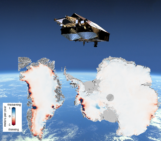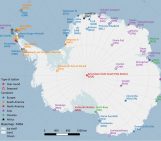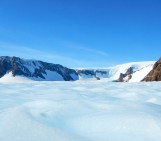
Figure 1a: Atmospheric formations on the interior Antarctic plateau near Dome Fuji. Photo credit: B. Van Liefferinge
How peaceful it is to contemplate the sky … This is especially true of polar northern or southern skies where the low temperatures can engender unique light phenomena. We often tend call them all, wrongly, sundogs, but in fact, many more phenomena exist. To list a few, you can observe a parhelic circle, a 22° halo, a pair of sun dogs, a lower tangent arc, a 46° halo, a circumzenithal arc, a parry arc, … This year, I had the chance to observe several of these phenomena during my fieldwork on the Antarctic plateau. I am no cloud specialist or meteorologist, but I would like to give you some explanations to better understand this sky art you might see one day.

Figure 1b: Atmospheric formations on the interior Antarctic plateau near Dome Fuji. Photo credit: B. Van Liefferinge
Everything starts with the ice crystals inside the clouds. Ice crystals can be approximated as hexagonal prisms, and two shapes can be found naturally: plates and columns (Fig.2), mainly dependent on air temperature and humidity. Clouds formed from these ice crystals are relatively thin and therefore sun rays can pass through them easily. In cold regions (polar or not), the ice crystals can also be found at ground level (in that case, they are called diamond dust).

Figure 2: atmospheric halos in the Antarctic plateau, 27 November 2018. Plate crystal (left) and column crystal (right), modified from Walter Tape, 1994. Photo credit: B. Van Liefferinge
The observed light patterns in the sky are caused by the refraction of sun rays on the ice crystals. As they hit the crystals, the sun rays are diverted from their trajectory. Depending on the orientation of the crystals in the cloud, and the type of crystal present in the cloud, this will affect the sun ray paths differently. The resulting halos or arcs seen in the sky will result from the combination of all the different ray paths through all the clouds’ crystals together. The sun ray paths through the crystals can become quite complex, as illustrated in Fig. 3.

Figure 3: Example of a complex ray path through a plate crystal which contributes to forming a left parhelic circle (left), example of a complex ray path through a hexagonal crystal which contributed to forming a tricker arc (right), (Walter Tape, 1994). Photo credit: B. Van Liefferinge
As an example, let’s try to understand how the 22° halo forms (see Fig.1 a and b), one of the most common halos observed. The 22° halo is formed in clouds that have randomly oriented column crystals (although this is still under debate). When a sun ray hits an ice crystal, the most common path it will take is to refract through the face of the hexagon it hits (e.g. face 1 on Fig.4) and refract back out of a face opposite (face 3 on Fig.4). The angle between face 1 and face 3 is of 60°. A light ray passing through two faces of an ice crystal inclined at 60° from each other is deflected through angles from 22° up to 50°. The deflection at 22° is the most probable and therefore creates the brightest circle in the sky (the 22° halo!). The other deflections above 22° are less common but occur nonetheless and form the fade disk (Fig. 4). No light can be refracted through smaller angles then 22° (this is a result of the air-to-ice index of refraction). This is why you see a “darker sky” inside the halo. Now, add to this that we have been considering white light in general. But in fact, visible white light is composed of visible red through blue rays, which do not deviate by the same amount (21.54° for red light to 22.37° for blue light). This explains why the 22° halo looks like a rainbow.

Figure 4: Sun ray path through an ice crystal (left), resulting 22° halo (right) [Credit: B. Van Liefferinge].
Now let’s go back to our famous sundog. If you understood the 22° halo, it will be a piece of cloud! Sundogs follow the same rule as the 22° halo: sun rays passing through two ice crystal faces inclined at 60° to each other are deflected through a minimum angle of 22°. The difference here is that for a sundog to form, the ice crystals must all be aligned along the horizontal direction. This is the case when the ice crystals are all plate crystals (Fig.5), which, as a result of their shape, tend to align horizontally in clouds. As sun rays traverse them, they are deflected into two specific spots either side of the sun, instead of along a circle when crystals are randomly oriented (like for the 22° halo).

Figure 5: Sundog formation [Credit: Atmospheric Optics website]
A few more fun facts:
- The sun’s elevation also plays a substantial role in the shape and the intensity of halos and arcs.
- Moonlight can also produce halos in the atmosphere.
- I encourage people who want to know more to have a look at the book “Atmospheric Halos” by Walter Tape and on the Atmospheric Optics website.
Edited by Marie Cavitte
 Brice Van Liefferinge is a trained geographer, glaciologist and modeller. With a background in geography at the Université libre de Bruxelles (ULB, Belgium), he pursued his interest in Earth sciences during his PhD looking at the thermal regime of the Antarctic Ice Sheet and working on the Beyond Epica Oldest Ice project. He is now working on the Oldest Ice Dome Fuji project with Dr. Kenny Matsuoka at the Norwegian Polar Institute (NPI, Tromsø, Norway) for which he just came back from 3 months of fieldwork at Dome Fuji, Antarctica.
Brice Van Liefferinge is a trained geographer, glaciologist and modeller. With a background in geography at the Université libre de Bruxelles (ULB, Belgium), he pursued his interest in Earth sciences during his PhD looking at the thermal regime of the Antarctic Ice Sheet and working on the Beyond Epica Oldest Ice project. He is now working on the Oldest Ice Dome Fuji project with Dr. Kenny Matsuoka at the Norwegian Polar Institute (NPI, Tromsø, Norway) for which he just came back from 3 months of fieldwork at Dome Fuji, Antarctica.





Marianne Bellstedt
Fascinating! Thank you for sharing.